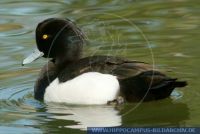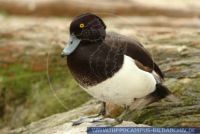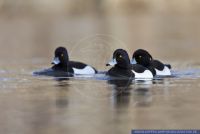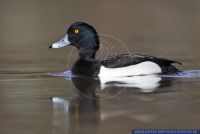Aythya fuligula
Tufted Duck
Exif Keywords: Natur, Nature, Animals, Tiere, Fauna, Voegel, Vogel, Bird, Fliegen, Fly
Exif ImageDescription: Aythya fuligula, Reiherente, Tufted Duck
The Tufted Duck, Aythya fuligula is a medium-sized diving duck with a population close to one million birds.The adult male is all black except for white flanks and a blue-grey bill. It has an obvious head tuft that gives the species its name.The adult female is brown with paler flanks, and is more easily confused with other diving ducks. In particular, some have white around the bill base which resembles the scaup species, although the white is never as extensive as in those ducks. The only duck which is at all similar is the drake North American Ring-necked Duck, which however has a different head shape, no tuft and greyish flanks. The Tufted Duck is one of the species to which the Agreement on the Conservation of African-Eurasian Migratory Waterbirds (AEWA) applies.The Tufted Duck breeds widely throughout temperate and northern Eurasia. It occasionally can be found as a winter visitor along both coasts of the United States and Canada. It is believed to have expanded its traditional range with the increased availability of open water due to gravel extraction, and the spread of freshwater mussels, a favourite food. These ducks are migratory in most of their range, and winter in the milder south and west of Europe, southern Asia and all year in most of the United Kingdom. They will form large flocks on open water in winter.Their breeding habitat is close to marshes and lakes with plenty of vegetation to conceal the nest. They are also found on coastal lagoons, the seashore, and sheltered ponds.These birds feed mainly by diving, but they will dabble. They eat molluscs, aquatic insects and some plants and sometimes feed at night.Source:Wikipedia
Viewed 5961 times









